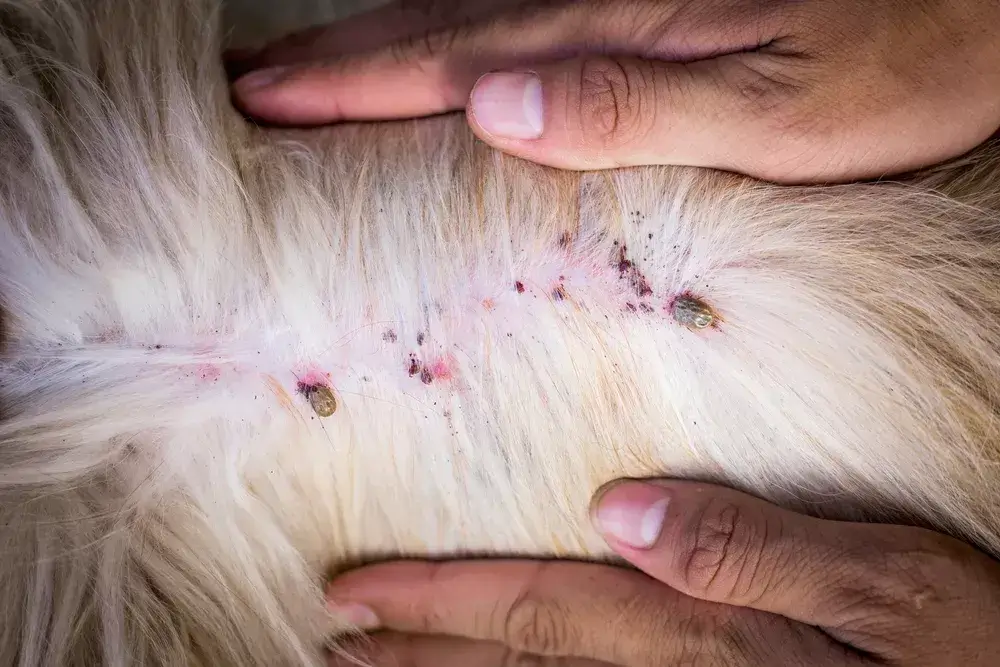How to Remove an Embedded Tick From Your Dog
Ticks are more than just an irritation for dogs—they are potential carriers of severe diseases like Lyme disease, ehrlichiosis, and anaplasmosis. If you’ve discovered a tick embedded fully in your dog’s skin, removing it carefully and promptly is crucial to reduce the risk of infection or illness. This comprehensive guide walks you through removing an embedded tick, what to do after removal, and how to prevent future infestations.
Contents
What is an Embedded Tick?
Ticks latch onto your dog by burrowing their mouthparts deep into the skin, anchoring themselves in place while feeding on blood. An “embedded tick” refers to a tick that has pierced the skin and attached firmly.
Understanding Tick Behavior and Embedding Process
Ticks are opportunistic parasites that wait for hosts, such as dogs, in grassy or wooded areas. Once on the host, they seek a location with thin skin, like the ears, neck, or between the toes, to embed themselves. The tick inserts its barbed mouthparts into the skin and secretes a cement-like substance to keep it attached while feeding for several days.
Common Tick Species Affecting Dogs
- Black-legged (Deer) Tick: A primary carrier of Lyme disease.
- American Dog Tick: Known to spread Rocky Mountain spotted fever.
- Brown Dog Tick: Often found indoors, particularly in kennels and homes.
Why is it Important to Remove an Embedded Tick Quickly?

Leaving an embedded tick on your dog can lead to significant health problems. The longer the tick is attached, the greater the risk of transmitting diseases.
Health Risks of Ticks on Dogs
- Tick-Borne Diseases: Ticks can carry pathogens that cause diseases such as:
- Lyme Disease: A common infection from deer ticks that can lead to fever, joint pain, and lethargy.
- Ehrlichiosis: Transmitted by brown dog ticks, this disease can cause blood cell damage, weight loss, and neurological symptoms.
- Anaplasmosis: A bacterial disease that causes fever, lameness, and joint inflammation.
How Long Does It Take for a Tick to Transmit Diseases?
Ticks must typically be attached for 24 to 48 hours before transmitting Lyme disease. Other diseases, like ehrlichiosis, may be transmitted in less time, underscoring the importance of early removal.
Step-by-Step Guide to Remove an Embedded Tick
Removing an embedded tick requires patience and the right tools. Here’s how you can safely remove it from your dog at home.
Tools You’ll Need for Safe Tick Removal
- Tweezers or a Tick Removal Tool: Preferably fine-point tweezers or a specialized tick removal hook.
- Gloves: To prevent direct contact with the tick.
- Isopropyl Alcohol: This is used to clean the tick bite area and disinfect your tools.
- Antiseptic Solution: To clean the wound after tick removal.
How to Use Tweezers to Remove the Tick
- Grasp the Tick: Grab the tick as close to your dog’s skin with fine-point tweezers as possible.
- Pull Slowly and Steadily: Apply even pressure without twisting or jerking. Pull the tick out in one smooth motion.
- Avoid Crushing the Tick: Be gentle to avoid squeezing the tick’s body, which could release infectious fluids into your dog’s bloodstream.
How to Use a Tick Removal Tool (Hook or Twister)
- Position the Tool: Place the hook of the tick removal tool between the tick and the dog’s skin.
- Twist and Lift: Slowly twist the tool while lifting it upwards. This will safely remove the tick without leaving its mouthparts behind.
What NOT to Do When Removing a Tick
- Do Not Use Heat: Burning a tick with a match can cause it to burrow deeper into the skin.
- Do Not Smother the Tick: Substances like petroleum jelly or alcohol are ineffective and may cause the tick to regurgitate into the wound, increasing the risk of infection.
What to Do After Removing the Tick?
Once you’ve successfully removed the tick, follow these steps to ensure your dog remains healthy and free of infections.
Cleaning the Wound Properly
- Disinfect the Area: Apply an antiseptic solution, such as chlorhexidine or iodine, to the bite site to prevent infection.
- Please dispose of the Tick: Place the tick in a sealed bag or container with rubbing alcohol to kill it. Never crush a tick with your fingers.
Monitoring Your Dog for Signs of Tick-Borne Illness
Even after removing the tick, it’s essential to watch for any signs of illness. Symptoms of tick-borne diseases may not appear immediately, so remain vigilant for the next 30 days.
- Symptoms to Watch For:
- Fever
- Lethargy or weakness
- Joint pain or swelling
- Loss of appetite
Contact your veterinarian for further guidance if you notice any of these symptoms.
How to Prevent Ticks from Embedding in Your Dog
Preventing ticks from latching onto your dog is more accessible than treating the health complications they can cause. Here are some practical prevention methods.
Tick Prevention Methods
- Topical Treatments: Products like Frontline or Advantix can be applied to your dog’s skin to kill ticks on contact.
- Oral Medications: Chewable tablets such as NexGard or Bravecto provide month-long protection against ticks.
- Tick Collars: Seresto collars are effective for up to 8 months in preventing tick attachment.
Best Practices for Tick Checks After Outdoor Activities
After walks in wooded or grassy areas, perform a thorough tick check, especially in these areas:
- Under the collar
- Between the toes
- Inside the ears
- Around the neck
Areas on Your Dog Most Prone to Ticks
Ticks prefer warm, moist areas on a dog’s body, such as:
- Behind the ears
- Armpits
- Groin area
FAQs
How to Remove an Embedded Tick on a Dog at Home?
Using fine-point tweezers or a tool, you can safely remove an embedded tick at home. Be sure to grasp the tick close to the skin and pull straight out without twisting.
What Happens if a Tick Gets Embedded in Your Dog?
If a tick remains embedded, it increases the risk of transmitting diseases like Lyme or ehrlichiosis. Immediate removal is vital in preventing infection.
What if My Dog Won’t Let Me Remove a Tick?
If your dog resists, try distracting them with treats or have someone assist in holding them. If all else fails, consult your vet for help removing the tick.
What Kills Ticks on Dogs Instantly?
Products like NexGard (oral) or Advantix (topical) kill ticks on contact or ingestion, making them practical for treatment and prevention.
Conclusion
Removing an embedded tick from your dog is an essential skill every dog owner should possess. Quick and effective removal can prevent serious health issues associated with tick-borne diseases, which pose significant risks to your pet’s well-being. Using the right tools and techniques, such as fine-point tweezers or a tick removal tool, can make the process safer and more successful.
Post-removal care is equally important. Cleaning the wound and monitoring your dog for any signs of illness can help ensure your pet stays healthy. Furthermore, employing preventive measures—like topical treatments, oral medications, and regular tick checks—can significantly reduce the likelihood of ticks embedding themselves in the first place.
- Golden Retriever Pros and Cons: What Every Pet Parent Should Know - 15 September 2025
- Cane Corso Dog Breed: Health, Care, and Lifespan - 14 September 2025
- Catahoula Leopard Dogs: Description, Temperament, Lifespan, & Facts - 21 July 2025







